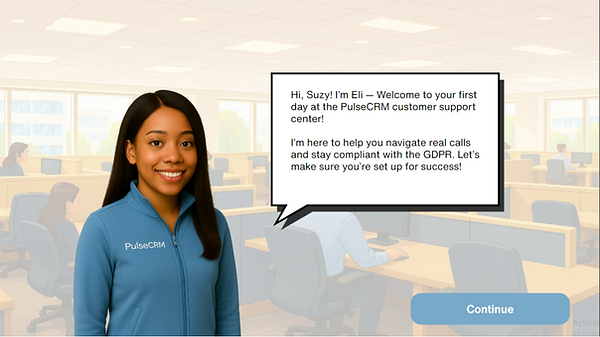The Data Line
A scenario-based data-compliant training experience for onboarding customer support agents.

Audience: Onboarding customer support agents
My Role: Instructional Design, Action Mapping, Storyboarding, Visual & Graphic Design, Development, Prototyping, and Iteration
Tools Used: Articulate Storyline 360, DALL-E, Google Docs , Canva, ChatGPT
The Problem
Customer support agents often face real-time decisions involving personal data: from verifying identities to handling deletion requests. But while GDPR (General Data Protection Regulation) sets clear expectations for data handling, support staff aren’t always trained to apply these rules in live conversations.
The Solution
I designed a scenario-based, interactive learning experience designed to help support agents confidently apply GDPR principles in context.
Learners step into the role of a new agent at PulseCRM and handle realistic customer interactions. Through decision-making, feedback, and consequences, they learn how to:
-
Keep personal data secure
-
Collect only what’s necessary
-
Communicate data use transparently
-
Escalate when required
-
Uphold trust while staying compliant
Rather than memorizing rules, learners experience the real impact of their choice.







My Process
Analysis
To simulate a real-world training need, I started by identifying a business goal:
Reduce the risk of non-compliant data handling incidents to near zero within three months.
To support this goal, I defined a specific performance objective:
Customer support agents will handle personal data in accordance with GDPR regulations.
To identify what learners need to do, I used Cathy Moore’s action mapping approach:
-
Mapped the core GDPR-compliant behaviors expected during support interactions
-
Identified common obstacles
-
Designed targeted supports such as job aids and scenario-based learning (SBL) to help overcome those obstacles
Although this was a fictional project, I followed a real-world design process by:
-
Studying the official 7 GDPR principles and related best practices
-
Mapping realistic support conversations to potential compliance risks
-
Reverse-engineering key decision points where mistakes could lead to legal or reputational consequences
-
Creating a fictional company (PulseCRM) and diverse customer profiles to ground the scenarios in authentic service challenges
Design
Given the high-stakes nature of data handling, I selected scenario-based learning (SBL) as the primary instructional method. This approach allows learners to practice critical decision-making in a safe environment while seeing the consequences of their choices.
SBL is particularly effective for compliance training because:
-
It mirrors real-world decision points
-
It encourages deeper thinking and retention
-
It highlights the “gray areas” that job aids alone can’t address
Highlights:
-
Designed 4 branching scenarios, each focused on a high-impact decision
-
Developed a cumulative consequence system where each scenario impacts the final outcome
-
Created layered endings based on the learner’s decisions, promoting reflection and accountability
-
Wrote a text-based storyboard with realistic dialogue and choices
-
Introduced a mentor character (“Eli”) to provide just-in-time feedback and guidance
-
Designed 4 learner avatars to support personalization and improve engagement
Visual Mockups:
Development
To bring the learning experience to life, I used a combination of tools and workflows to support content creation, media design, and eLearning development.
Content Development:
-
Drafted scenarios, realistic dialogue, and in-the-moment feedback in Google Docs
-
Created action mapping diagrams to guide learner pathways and interaction flow
-
Wrote layered consequences to align with learner decisions across multiple scenarios
Media Production
-
Used DALL·E to generate consistent character avatars for scenario realism
-
Designed the user interface (UI) and visual assets in Canva, applying a calming color palette to evoke trust and psychological safety
-
Ensured all visuals supported the tone and purpose of the compliance training
eLearning Assembly
-
Developed the full module in Articulate Storyline 360
-
Integrated branching logic, feedback, and learner-driven interactions
-
Used custom navigation to support exploratory learning while maintaining clarity
-
Ensured the experience was visually cohesive, intuitive, and accessible

.png)
Challenges
One of the most significant challenges in this project was working independently without immediate access to a subject matter expert (SME) or a team of collaborators. As someone who values feedback and iteration, the lack of real-time input made it more difficult to validate decisions and refine content.
To overcome this, I:
-
Conducted in-depth research into GDPR using credible sources, including official EU documentation
-
Reverse-engineered common compliance issues by analyzing real-world support scenarios
-
Reached out to a cohort of peer instructional designers to gather feedback and gain diverse perspectives
This experience reinforced the importance of collaboration, resourcefulness, and continuous feedback in the instructional design process. It also deepened my ability to work autonomously and creatively solve problems, which are essential skills for client work and agile environments.